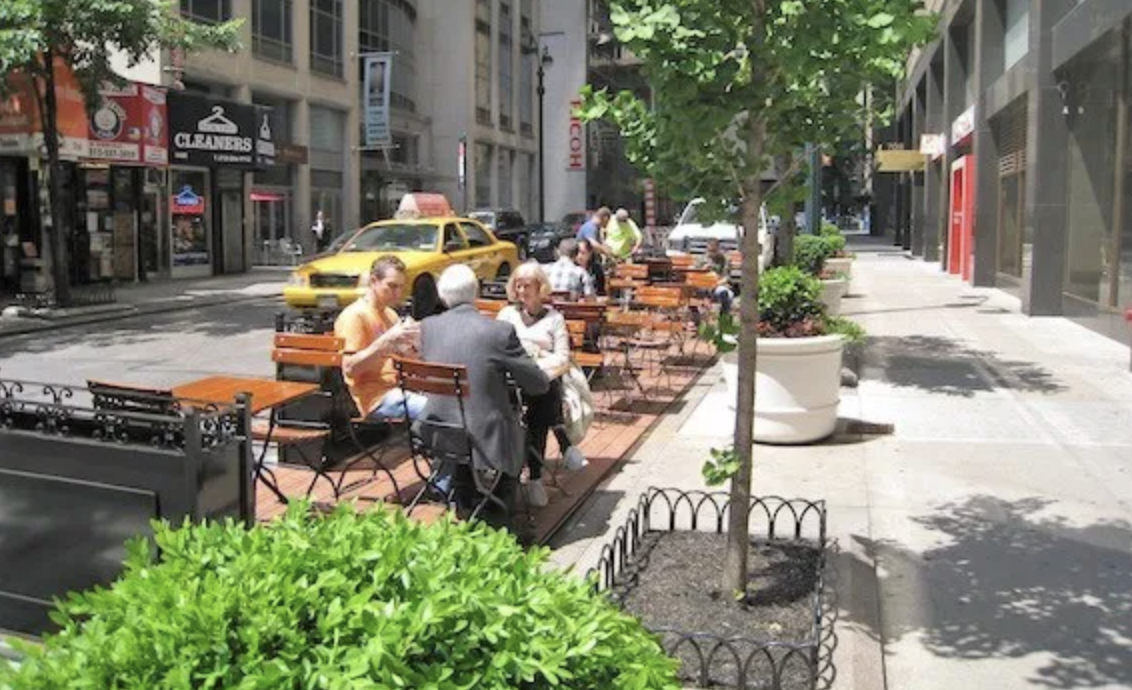The Sacramento Bee recently published an article[1] about opening up sidewalks and streets for dining. Mayor Darrell Steinberg dubbed it, “Farm to Fork Al Fresco,” a catchy name capturing the essence of the food scene here in Sacramento. The idea is to open up space for diners and maintain social distancing, while helping restaurant owners fill seats to more than 50% capacity, which is, on average how much seating space is lost if all tables are distanced at six feet.[2]
Where does the extra space come from? In cities such as Paris, which has had outdoor seating at cafes and bistros for decades, the extra seating is on the sidewalk, either abutted to the restaurant or out farther adjacent to the street edge, with a wide space for pedestrians to pass through on the sidewalk. Few of our sidewalks in Sacramento are wide enough for that, and adding tables to the area would likely force pedestrians out into the street to maintain social distance as they navigate the corridor.
Instead, we could follow many other cities worldwide whose streets are being partially or fully closed to cars and businesses. They are able to add more space with a “parklet,” borrowing the parking spaces in front of their establishments.[3]

Tampa, FL is allowing businesses to establish parklets on the sidewalk immediately adjacent to their establishment or in their parking spaces.[4] Applying for a city permit is suspended during their pilot program; however, property manager approval remains a requirement. The city will work with the business owner to temporarily disable parking meters so the parking spaces can be repurposed for use by the business. Some cities have been leaving one side of the road open to parking and the other to pedestrians. Restaurants may set up tables and chairs in these parklets as long as they are adhering to health and safety standards. Diners are seated through a reservation system to avoid gathering while waiting for a table.
Long Beach is moving in the same direction. The need for the extra space is what could make or break a business. One restaurant owner shared the math: 50% occupancy simply means 50% of the profits, which doesn’t add up when rent, utilities, wages and insurance are all at 100%.[5] The extra space is crucial to the equation of whether or not it’s a viable business model. Likewise, research has shown that places built for people but are less car-centric are more likely to be economically viable.[6]
The coronavirus is pushing us to think differently when it comes to the safety of our citizens and jumpstarting the economy, and using space in a different way is emerging as a key factor.[7] Following the lead of other cities around the world, Sacramento should close down streets typically reserved for driving and parking and open them up to accommodate diners at a safe distance, boosting much needed economic growth. The city is already working on a plan to close a few streets so that more people can get outside and enjoy some fresh air while maintaining social distance.

Closing streets to vehicular traffic isn’t new or radical. In the 1970s, roads were closed off to create downtown walking malls, and these days major thoroughfares are closed to cars a few times a year for large events, such as the Sacramento International Marathon, or the Amgen Tour of California. Sacramento has already toyed with Open Street or Ciclovia projects, where the roads are closed for a set amount of time, like Bogota, Columbia does every Sunday, and Los Angeles has been doing now for years.
The list is long of cities who have taken steps to change their streets into places where people can move about free from concern of being too close. London, Paris, Barcelona, Bogota, Lima, Berlin, Vilnius, Santa Monica, Long Beach, Tampa, Charleston, Cincinnati, and Oakland have all embraced making changes to their streets.[8]
A prominent New York chef summed it up this way: “[What’s] the best dish on the menu? Safety. Restaurateurs will serve this one dish as they try to re-open. What’s true is that to safely serve this up, space is the key ingredient.”[9] So we urge you, our City leaders, to open our streets to people, extend sidewalks, create parklets and ease permitting so that businesses may serve us safely. Let’s enjoy it, “al fresco”.
[1] https://www.sacbee.com/news/local/article242712226.html?utm_source=pushly&intcid=%7B__explicit:pushly_531639%7D
[2] https://lbpost.com/hi-lo/addison-coronavirus-commentary-restaurants-close-off-roads?fbclid=IwAR0hEsm9PnEQrnAmcUwIirDzpIwi1_VmlI937fv_63iBjSD5bDDgDLhL5MY
[3] https://sf.streetsblog.org/2020/05/12/for-small-biz-to-survive-sidewalks-must-thrive/
[4] https://patch.com/florida/southtampa/tampa-expands-outdoor-restaurant-seating-sidewalks-roads
[5] https://lbpost.com/hi-lo/addison-coronavirus-commentary-restaurants-close-off-roads?fbclid=IwAR0hEsm9PnEQrnAmcUwIirDzpIwi1_VmlI937fv_63iBjSD5bDDgDLhL5MY
[6] https://www.smartgrowthamerica.org/app/legacy/documents/cs/factsheets/cs-economic.pdf, https://fyi.extension.wisc.edu/downtowneconomics/files/2012/07/economic-benefits-of-a-walkable-community.pdf
[7] https://www.theatlantic.com/ideas/archive/2020/04/pandemic-shows-what-cities-have-surrendered-cars/610423/
[8] https://medium.com/@TransAlt/14-cities-getting-it-right-4ba7b78c920b
[9] https://www.scribd.com/document/461056931/Henry-Rinehart-Safe-Space-Open-Streets-And-Vibrant-Retail#download

